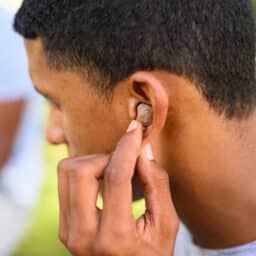Living with single-sided hearing loss, also known as unilateral hearing loss (UHL), presents unique challenges that can significantly impact daily life. However, recognizing the signs and implementing effective management strategies can help you navigate these challenges and improve your quality of life.
Understanding Single-Sided Hearing Loss
UHL occurs when a person experiences hearing loss in one ear while the other ear maintains normal hearing. Approximately one child in 1,000 is born with UHL, and an estimated 7% of adults in the United States live with the condition. UHL can result from various factors, including genetics, illness, injury or certain medical treatments.
Identifying the Signs
Recognizing the signs of UHL is crucial for early intervention and effective management. Common indicators of UHL include:
- Complete hearing loss in one ear. Individuals with UHL may notice a significant decrease or absence of hearing in one ear.
- Difficulty localizing sounds. Without input from both ears, it becomes challenging to accurately determine the direction of sounds.
- Tinnitus. Many individuals with UHL experience persistent ringing or buzzing in the affected ear.
- Difficulty hearing in noisy environments. Background noise can make it difficult to understand speech, particularly in crowded settings.
- Fatigue and social withdrawal. Straining to hear and participate in conversations can lead to exhaustion and a reluctance to engage socially.
How Can Your Hearing Specialist Help?
If you suspect you or a loved one may have UHL, seeking professional help from an audiologist is essential. They can conduct thorough assessments, including hearing tests and evaluations of speech understanding, to determine the extent of the hearing loss and recommend appropriate management options.
While UHL cannot be cured, several management strategies can help you cope with its effects and improve your hearing experience. Three common strategies include hearing aids, assistive listening devices and auditory training.
Hearing Aids
Hearing aids are a common and effective solution for UHL. They amplify sounds and help the wearer better perceive sounds from their hearing loss ear. You can wear hearing aids anytime, outside of sleeping and water-based activities. The small but powerful devices can help you better hear the specials at Longevity Coffee, the happy sounds of laughter in your home and more.
Cochlear Implant
A cochlear implant is a sophisticated medical device involving a surgical procedure to implant a tiny inner ear device. This implant works with an external auditory processor, which captures sound and converts it into electrical signals that directly stimulate the auditory nerve. Cochlear implants can significantly improve auditory perception and speech comprehension in people with severe to profound hearing impairment by bypassing the damaged or non-functioning parts of the inner ear responsible for hearing loss.
Auditory Training
Working with a speech-language pathologist or audiologist can help people with UHL develop strategies to improve communication skills and adapt to hearing loss.
Living with single-sided hearing loss can be challenging, but with the right support and management strategies, you can overcome many of the obstacles associated with this condition. By identifying the signs early and seeking the help of a qualified hearing specialist, you can effectively manage hearing loss and improve your overall quality of life. Contact Decibel Hearing Services today to begin your hearing treatment journey.

